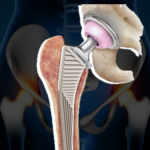
Only Centre in PCMC- Pune which Ensures 100% Use of Robot in Knee Replacement Surgery
Why Cuvis Robotic Arm And AI for Your Knee Joint?
Cuvis Robotic Arm and AI technology have revolutionized the field of knee replacement surgery. Dr Saurabh Giri, a leading knee replacement surgeon in Pune, is proud to offer this cutting-edge technology to his patients.
The Cuvis Robotic Arm is a state-of-the-art robotic surgical system that utilizes AI technology to accurately place knee implants with a high degree of precision. This technology enables Dr Giri to create a personalized surgical plan for each patient, based on their unique anatomy and needs.
By using the Cuvis Robotic Arm, Dr Giri can achieve a level of accuracy and precision that is difficult to achieve with traditional surgical techniques. This translates into better outcomes for his patients, with less pain and scarring, and faster recovery times.
Furthermore, the Cuvis Robotic Arm allows Dr Giri to perform minimally invasive knee replacement surgery, which means less trauma to the surrounding tissues and faster recovery times. This technique is particularly beneficial for patients who are at higher risk of complications or who have more complex cases.
The Meril Robotic Knee is a knee replacement surgery technology developed by Meril Life Sciences, a medical device company based in India. It is a robotic-assisted surgery system that uses a computerized tomography (CT) scan of the patient’s knee joint to create a 3D model, which is then used to plan the surgery and create a customized surgical plan for the patient.
In summary, by utilizing the Cuvis Robotic Arm and AI technology, Dr Saurabh Giri is able to provide his patients with the latest advancements in knee replacement surgery. If you are considering knee replacement surgery, contact or visit https://www.kneereplacementsurgeonpune.com – Dr Giri at his clinic in Pune to learn more about how this technology can benefit you.
Personalized pre-planning for better design, simulation, and precise insertion of artificial joints:
Personalised Planning
The surgeon uses 3D images of the patient’s joint to prepare for the surgery and customize it for the patient.
Implant pre-selection and Exact Placement
The surgeon chooses an implant for the patient and carefully inserts it using the robot.
Optimal Alignment and Accuracy through Precise Cutting
In accordance with the size of the implant chosen during the pre-surgery planning step, the robot carefully evaluates the data and cuts the bone.
AI for Your Knee Joint: How Technology is Transforming Orthopedic Care
Artificial intelligence (AI) is increasingly being used in the healthcare industry to improve patient outcomes, and one area that is benefitting from this technology is knee joint care. Knee joint conditions are a common problem, affecting millions of people worldwide. In recent years, there has been a growing interest in using AI to help diagnose and treat these conditions.
AI can be used in several ways to support knee joint care. One of the most promising applications is the use of machine learning algorithms to analyze imaging data, such as MRI and X-rays. These algorithms can quickly identify abnormalities or patterns that may be difficult for human physicians to detect. For example, AI algorithms can be trained to identify bone density changes that may indicate early signs of knee osteoarthritis, a degenerative condition that affects the knee joint.
Another application of AI in knee joint care is the development of wearable devices that can monitor joint movement and provide feedback on joint health. These devices can collect data on a patient’s gait, range of motion, and other movement patterns, which can then be analyzed to identify abnormalities that may indicate a problem with the knee joint. By detecting problems early, these devices can help patients take proactive measures to prevent further damage and improve their overall knee joint health.
AI can also be used to develop personalized treatment plans for patients with knee joint conditions. By analyzing patient data, including medical history, imaging results, and movement patterns, AI algorithms can identify the most effective treatment options for individual patients. This can help physicians make more informed decisions about treatment, which can ultimately lead to better outcomes for patients.
One of the biggest benefits of using AI in knee joint care is the potential to improve patient outcomes while reducing costs. By detecting problems early and developing personalized treatment plans, AI can help patients avoid more invasive and expensive procedures, such as knee replacement surgery. Additionally, by reducing the need for in-person visits, AI can help make healthcare more accessible to patients who may have difficulty travelling to appointments.
How Does Cuvis Joint Replacement Surgery Benefit You?
Cuvis joint replacement surgery offers several benefits for patients, including:
- Precise and Accurate Placement: The Cuvis robotic arm and AI technology used in joint replacement surgery ensures that the implant is placed precisely and accurately, leading to better outcomes and a quicker recovery.
- Personalized Treatment: The advanced technology used in Cuvis joint replacement surgery allows for personalized treatment plans, tailored to the specific needs of each patient.
- Less Invasive: The minimally invasive nature of the Cuvis joint replacement surgery means that patients experience less pain and have a faster recovery time than with traditional joint replacement surgeries.
- Reduced Risk of Complications: The precise placement of the implant and the personalized treatment plan reduce the risk of complications during and after surgery.
Overall, Cuvis joint replacement surgery offers patients a safe, effective, and personalized approach to joint replacement surgery with better outcomes and a quicker recovery.
Conclusion
Cuvis joint replacement surgery offers a significant advancement in joint replacement surgery, with benefits for patients that go beyond traditional surgery techniques. The precision and accuracy of the Cuvis robotic arm and AI technology used in joint replacement surgery ensure that the implant is placed in the correct position, which can reduce wear and tear, increase the longevity of the implant, and improve the overall outcome of the surgery.
Dr Saurabh Giri, an experienced knee replacement surgeon at https://www.kneereplacementsurgeonpune.com/, uses Cuvis joint replacement surgery to provide his patients with a personalized approach to joint replacement surgery. He utilizes pre-planning techniques to design a treatment plan tailored to the specific needs of each patient. This approach ensures that each patient receives the best possible care and that the implant is placed precisely and accurately, leading to better outcomes and a faster recovery.
AI is a promising technology for knee joint care, offering a range of benefits for patients and physicians alike. As this technology continues to evolve, we can expect to see even more applications of AI in healthcare, including knee joint care. Dr Saurabh Giri, a renowned orthopedic surgeon at Helios Orthojoint, has been at the forefront of this technology, leveraging AI to improve patient outcomes and provide better care to his patients. With the continued collaboration between healthcare providers and AI developers, we can look forward to a future where knee joint care is more efficient, effective, and accessible for all.
If you are experiencing joint pain or are considering joint replacement surgery, contact Dr Saurabh Giri at https://www.kneereplacementsurgeonpune.com/ to learn more about the benefits of Cuvis joint replacement surgery and how it can help you regain your mobility and improve your quality of life.




